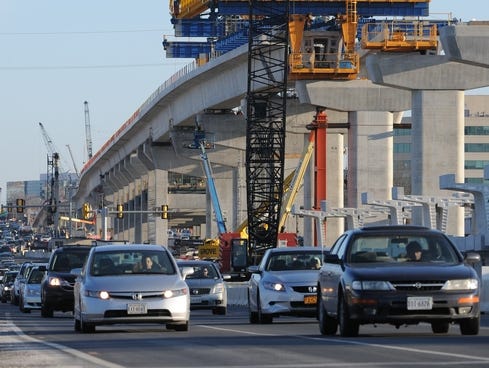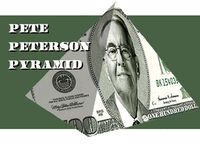UPDATE: On April 3, 2013 Governor McDonnell signed the package described below with only minor changes. Those changes are discussed at the end of this article.
If Governor Bob McDonnell signs the transportation bill just passed by his state’s legislature, as he is expected to do, Virginia will join Wyoming as the second Republican-led state in less than a month to raise taxes to pay for transportation. Virginia Delegate David Albo, one of Grover Norquist’s no tax pledge signers, explained his vote in favor of the bill by saying, “I looked at every single way to raise money for roads, and it is literally impossible to do without raising revenue.”
But as encouraging as it is to see opposition to taxes waning in some circles, the tax bill passed by Virginia’s legislature is far from perfect. The bill will shift the responsibility for paying for roads away from the drivers who use them most, and its reliance on sales taxes will shift Virginia’s already regressive (PDF) tax system even more heavily toward lower-income families. Here’s a quick rundown of the bill’s major components:
Gasoline tax: The 17.5 cent per gallon gasoline tax will be cut, at least in the short-term, by replacing it with a tax based on 3.5 percent of the wholesale price of gasoline. At the current wholesale price of $3.30 per gallon, the new tax should be about 11.5 cents—the lowest in the country outside of Alaska—but it will rise over time as the price of gas climbs. Virginia will become the 15th state to levy a gas tax that grows automatically over time, which allows the tax to better keep pace with the rising cost of construction. But wholesale gas prices will have to rise to $5.00 per gallon before the tax returns the 17.5 cent level that Virginians have been paying for the last quarter century. The bill amounts to a gas tax cut that lets frequent and long-distance drivers off the hook for paying for the transportation enhancements that benefit them the most.
Diesel tax: Taxes on diesel fuel will increase both in the short- and long-term, as the 17.5 cent per gallon tax is replaced by a 6 percent tax based on the wholesale price of diesel. Diesel prices are generally higher than gasoline prices, so at a wholesale price of $3.50, for example, the new tax should equal 21 cents per gallon and will grow over time as diesel prices rise.
Remote sales tax: The bill assumes that Congress will enact legislation empowering Virginia to require online retailers to collect the sales taxes owed by their customers (PDF), but it also puts in place a stopgap measure in case that doesn’t happen. If Congress hasn’t acted by 2015, the wholesale gasoline tax rate will rise from 3.5 percent to 5.1 percent. At current prices, this would bring the gas tax to16.8 cents per gallon. Virginia should raise its wholesale gas tax rate to at least this level, regardless of the outcome of the federal debates over taxing online purchases.
Sales tax: The largest single revenue-raiser in the bill is an increase in the state sales tax rate from 5 percent to 5.3 percent in most parts of the state. In the densely populated and congested areas of Northern Virginia and Hampton Roads, residents will see their sales tax rates rise to 6 percent, and will be forced to dedicate the additional revenue to transportation.
 General fund raid: Following the unfortunate precedent set by Michigan, Nebraska, Oklahoma, Utah, Wisconsin and the federal government, the bill also prioritizes roads over other areas of government by shifting $200 million away from the general fund every year. The Roanoke Times previously blasted a similar proposal from Governor McDonnell by pointing out: “The highway program is starved for money because the gas tax rate has not changed since 1987. Are teachers and their students to blame? No, they are not. Did doctors and mental health workers cause the problem? Absolutely not. Did sheriff’s deputies and police officers? No.”
General fund raid: Following the unfortunate precedent set by Michigan, Nebraska, Oklahoma, Utah, Wisconsin and the federal government, the bill also prioritizes roads over other areas of government by shifting $200 million away from the general fund every year. The Roanoke Times previously blasted a similar proposal from Governor McDonnell by pointing out: “The highway program is starved for money because the gas tax rate has not changed since 1987. Are teachers and their students to blame? No, they are not. Did doctors and mental health workers cause the problem? Absolutely not. Did sheriff’s deputies and police officers? No.”
Motor vehicle sales tax: The sales tax break on motor vehicle purchases will be reduced, but not eliminated. The rate will rise from 3 percent to 4.3 percent – still short of the 5.3 percent general sales tax rate.
Hybrid tax: Hybrid and alternative fuel vehicles will have to pay an additional $100 in registration taxes every year. So, while drivers of gas-guzzling vehicles are receiving a break in the form of a lower gas tax, fuel-efficient hybrid owners will actually pay more.
Low-income offsets: The state and local sales taxes used to raise the bulk of new road funding under this plan will hit lower- and moderate income families hardest. And yet, the bill lacks any kind of targeted tax relief for those families. In-state analysts urged the creation of a sales tax rebate or the enhancement of the state’s Earned Income Tax Credit (EITC), but the final bill did not include either of these measures.
UPDATE: The version of this package that was signed into law is slightly different than the one originally passed by the legislature: the motor vehicle sales tax is raised to 4.15 percent instead of 4.3 percent, the hybrid tax is $64 per year instead of $100, miscellaneous local tax increases in northern Virginia were scaled back, and technical changes were made to local taxes in order to avoid a constitutional challenge.
 The Center for Media and Democracy (CMD), creator of the indispensible wiki, SourceWatch, recently launched a new wiki resource allowing users to explore the funding, leadership, partner groups and lobbyists that make up the Campaign to Fix the Debt. This resource reveals Fix the Debt for what it really is: another coordinated push by large corporations and billionaire Pete Peterson to force Congress to pass large and unneeded cuts to Social Security and Medicare.
The Center for Media and Democracy (CMD), creator of the indispensible wiki, SourceWatch, recently launched a new wiki resource allowing users to explore the funding, leadership, partner groups and lobbyists that make up the Campaign to Fix the Debt. This resource reveals Fix the Debt for what it really is: another coordinated push by large corporations and billionaire Pete Peterson to force Congress to pass large and unneeded cuts to Social Security and Medicare. 371 Productions, the creator of the PBS documentary, “As Goes Janesville,” has launched a corporate transparency website and iPhone app called BizVizz, which provides consumers with easy access to financial information about America’s largest corporations. BizVizz uses CTJ’s corporate tax data to reveal that our broken corporate tax system allows the makers of many of our everyday products to get away with paying little – or sometimes nothing – in income taxes. One especially cool feature of the app allows the user to snap a picture of a product logo and get instant information on how much the company paid in federal taxes.
371 Productions, the creator of the PBS documentary, “As Goes Janesville,” has launched a corporate transparency website and iPhone app called BizVizz, which provides consumers with easy access to financial information about America’s largest corporations. BizVizz uses CTJ’s corporate tax data to reveal that our broken corporate tax system allows the makers of many of our everyday products to get away with paying little – or sometimes nothing – in income taxes. One especially cool feature of the app allows the user to snap a picture of a product logo and get instant information on how much the company paid in federal taxes.




 In 2011, Michigan lawmakers enacted a huge “
In 2011, Michigan lawmakers enacted a huge “ General fund raid: Following the
General fund raid: Following the  In his budget address this week, Wisconsin Governor Scott Walker followed through on his promise to
In his budget address this week, Wisconsin Governor Scott Walker followed through on his promise to  We’ve been closely following
We’ve been closely following  A couple of years ago, the Institute on Taxation and Economic Policy (
A couple of years ago, the Institute on Taxation and Economic Policy (